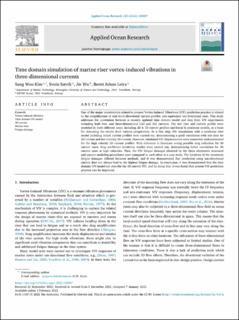| dc.contributor.author | Kim, Sangwoo | |
| dc.contributor.author | Sævik, Svein | |
| dc.contributor.author | Wu, Jie | |
| dc.contributor.author | Leira, Bernt Johan | |
| dc.date.accessioned | 2022-08-05T10:34:25Z | |
| dc.date.available | 2022-08-05T10:34:25Z | |
| dc.date.created | 2022-04-25T13:59:53Z | |
| dc.date.issued | 2022 | |
| dc.identifier.citation | Applied Ocean Research. 2022, 120 . | en_US |
| dc.identifier.issn | 0141-1187 | |
| dc.identifier.uri | https://hdl.handle.net/11250/3010330 | |
| dc.description.abstract | One of the major uncertainties related to present Vortex-Induced Vibrations (VIV) prediction practice is related to the simplification of real multi-directional current profiles into equivalent uni-directional ones. This study addresses the correlation between a recently updated time domain model and data from VIV experiments including both two- and three-dimensional (2D and 3D) currents. The test riser and current profile were modeled in three different ways, including 2D & 3D current profiles and linear & nonlinear models, as a basis for discussing the results from various perspectives. As a first step, VIV simulations with a nonlinear riser model including actual current profiles were carried out, demonstrating a good correlation with test data for 2D current and low velocity 3D current. However, simulated VIV displacements were somewhat underestimated for the high velocity 3D current profiles. With reference to literature noting possible drag reduction for 3D current cases, drag coefficient sensitivity studies were carried out, demonstrating better correlation for 3D current cases at high velocities. Then, the VIV fatigue damages obtained by the three alternative structural and current modeling procedures were compared to each other in a case study. The locations of the maximum fatigue damages differed between methods, and it was demonstrated that prediction using uni-directional current does not always lead to the highest fatigue damage. In conclusion, it was demonstrated that the time domain VIV model can describe the 3D current VIV, and by doing that, it was found that present VIV prediction practice can be improved. | en_US |
| dc.language.iso | eng | en_US |
| dc.publisher | Elsevier | en_US |
| dc.rights | Navngivelse 4.0 Internasjonal | * |
| dc.rights.uri | http://creativecommons.org/licenses/by/4.0/deed.no | * |
| dc.title | Time domain simulation of marine riser vortex-induced vibrations in three-dimensional currents | en_US |
| dc.title.alternative | Time domain simulation of marine riser vortex-induced vibrations in three-dimensional currents | en_US |
| dc.type | Peer reviewed | en_US |
| dc.type | Journal article | en_US |
| dc.description.version | publishedVersion | en_US |
| dc.rights.holder | © 2022 The Author(s). Published by Elsevier Ltd. | en_US |
| dc.source.pagenumber | 18 | en_US |
| dc.source.volume | 120 | en_US |
| dc.source.journal | Applied Ocean Research | en_US |
| dc.identifier.doi | 10.1016/j.apor.2022.103057 | |
| dc.identifier.cristin | 2018937 | |
| dc.source.articlenumber | 103057 | en_US |
| cristin.ispublished | true | |
| cristin.fulltext | original | |
| cristin.qualitycode | 1 | |

